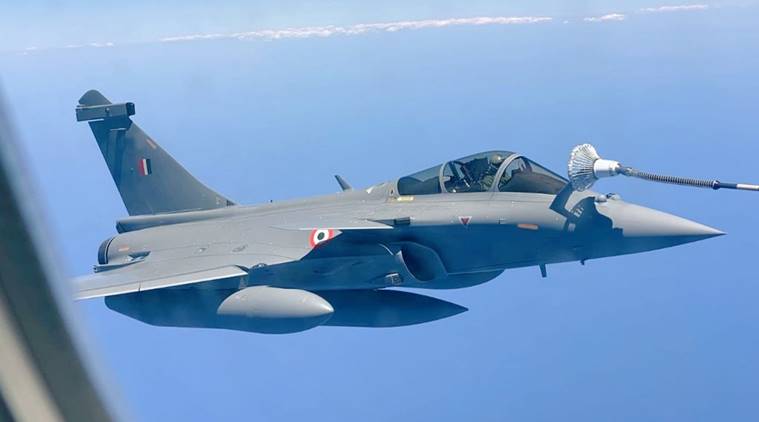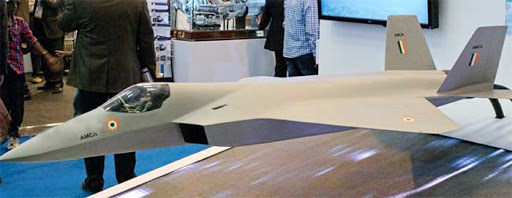THE RAFALE: A FORCE MULTIPLIER
2020 JUL 30
Mains >
Security > Border area management > Technology in border management

IN NEWS:
- The first five of the 36 French-made Rafale jet fighters have arrived at Ambala, Haryana.
DASSAULT RAFALE:
- The Dassault Rafale is a French twin-engine, multirole fighter aircraft designed and built by Dassault Aviation.
- The nuclear-capable combat jet is designed for air-to-air and air-to-ground attack and its on-board Electronic Warfare (EW) systems can perform reconnaissance and radar jamming roles.
- The 4.5 generation aircraft is 'Omnirole' by design, i.e. the capability to perform several actions at the same time such as Reconnaissance, Air-to-ground precision strike, anti-ship attacks, nuclear deterrence and mid-air refueling.
- They come in one-seat & two-seat versions and can be armed with air-to-air, air-to-ground and anti-ship missiles. Meteor beyond visual range air-to-air missile, SCALP cruise missiles and MICA weapons will be integrated to the fighters.
- Besides the Indian Air Force, the Rafale has been selected for purchase by the Egyptian and the Qatar Air Forces.
RAFALE DEAL:
- The Rafale was chosen in 2012 over rival offers, as part of India’s Medium Multi-Role Combat Aircraft (MMRCA) competition, to upgrade the ageing fleet.
- The original plan was that India would buy 18 off-the-shelf jets, with 108 others being assembled in India by the state-run Hindustan Aeronautics Limited.
- Later, the new government decided to buy 36 "ready-to-fly" fighters instead of trying to acquire technology from Dassault and make it in India. The delivery of all 36 aircraft is set to be completed on schedule by 2022.
- In September 2016, India signed an inter-governmental agreement with France, dubbed as "Rafale deal", to buy Rafale fighters for a price estimated to be Rs. 58,000 crore or 7.8 billion Euros.
- As per the deal, India will also get spares and weaponry, including the Meteor and Scalp missiles.
- Additionally, an accompanying offset clause was sealed through which France will invest 30 per cent of the 7.8 billion Euros in India's military aeronautics-related research programs and 20 per cent into local production of Rafale components.
HOW RAFALE STRENGTHENS INDIA’S DEFENCE:
- Technological advantage: With its avionics, radars and weapon systems, the Rafale is the most potent aircraft in South Asia, much ahead of the F-16s that Pakistan uses or the J-20, the 5th generation stealth aircraft of China.
- Diversifies fleet strength: The Rafales represent the first strategically significant upgrade in India’s air power in decades. The Rafale is capable of operating under various conditions from both land as well as aircraft carriers. It is also the 7th addition to the types of fighters that the IAF has which includes Sukhoi-30MKI, MiG-27, MiG-29, Mirage 2000s, Jaguar and MiG-21 Bison — a feat very unique to the force in comparison to major air forces in the world.
- Proven reliability: The Rafale is combat proven, having been used by the French Air Force for its missions in Afghanistan, Libya and Mali. It has also been used for missions in Central African Republic, Iraq and Syria. Hence, it can be quickly deployed in the border areas.
- India specific additions: The 36 Rafales will have 13 Indian specific enhancements. These enhancements are incorporated to meet the peculiar conditions of India, such as the ability to start in very cold and high-altitude areas like Leh, among others.
- Accompanying arsenal: The Meteor is an air-to-air, ram-jet powered rocket, with a range of over 150 km. Scalp are long-range air-to-ground cruise missile with a 600-km range. The integration of these into the Rafale gives India strategic advantage along the tense border, as neither Pakistan nor China possess weapons of that caliber.
- Benefits indigenous industries: The offset clauses in the deal will go into various aeronautical and military research programmes in India and provide a great opportunity for indigenous manufacturers. France have also agreed in principle to collaborate on the Kaveri engine as part of the offset deal.
- Future benefits: Though a formal request is yet to be made, the IAF is planning to acquire more fighter jets in a staggered manner. France has out an offer for additional jets which will cost lesser than the present deal and will result in major offsets work to the Indian industry.
CHALLENGES:
- Insufficient numbers: The IAF currently has 30 fighter squadrons against a sanctioned strength of 42 squadrons. It is also set to phase out its MiG-21 fighters in the next few years, further reducing the strength. However, even when all the 36 Rafale jets are delivered by 2022, it will take it to 32 squadrons.
- Lack of sovereign guarantee: No sovereign guarantee has been signed in the Rafale deal. Only a ‘letter of comfort’ was given by France, which is neither legally binding, nor enforceable. Without a sovereign guarantee, either party can break the promise and go their different ways. This is undesired in matters involving public funds.
- Procurement mechanisms: Defence procurement deals in India have always been controversial, with allegations of corruption and crony capitalism marring almost every deal. This is because of the lack of an organizational structure with clearly defined procedures and robust overview mechanisms in defence acquisitions.
- Sidelines indigenization: Unlike previous defence deals of similar nature, the Rafale deal has no clause for technology transfer. Questions are also raised as to why state-run aerospace major Hindustan Aeronautics Limited (HAL) was not involved in the current deal.
- Redundant state-owned facilities: India has all the necessary ingredients for developing indigenous defence industries, ie. academies of excellence (IITs), dedicated research organisation (DRDO) and dedicated manufacturing facility (HAL). However, due to its total reliance on government funding, lack of reforms and time overruns, India continues to be heavily dependent on foreign suppliers for its capital acquisitions.
- Cost of jets: The opposition has been alleging that the government was procuring each aircraft at a cost of over Rs. 1,670 crores as against Rs. 526 crores finalized by the previous government. However, the government has insisted that it got significantly better terms than those quoted in the initial bid.
WAY FORWARD:
- Robust acquisition mechanisms: Considering the long history of delays and controversies in military acquisitions, robust and reliable procedures and overview mechanism must be put in place to ensure smooth, transparent and corruption free acquisitions in the future.
- Reform defence ecosystem: India needs to overhaul the defence ecosystem within the country, starting with the DRDO. The draft defense procurement procedure, 2020 is a promising move in this regard, as it promotes indigenization and seeks to boost domestic capabilities.
- Staggered purchase: The authorised strength of 42 fighter squadrons is the minimum strength necessary to dominate a two-front conflict. Hence, India cannot completely shy away from foreign acquisitions. However, India can opt for small staggered purchases, which will help meet immediate demand while encouraging the domestic defence industry.
- Strengthen indigenous capabilities: While Rafales give a major boost to India’s defence, it is important that this capability is complimented with similar capabilities on other platforms. This includes expanding indigenous capabilities in creating combat aircrafts, missiles and allied technologies.
- Corporatization & Private participation: As Kelkar committee suggested, all ordnance factories should be corporatized into a single corporation under the leadership of a competitive management. Also, private participation in the form of PPPs and startups should be encouraged.
ADD ON: HAL AMCA
The HAL Advanced Medium Combat Aircraft (AMCA) is an Indian programme to develop a fifth-generation fighter aircraft. The Aeronautical Development Agency (ADA) of the Defence Research and Development Organisation (DRDO) and the Indian Air Force (IAF) are in charge of the project. AMCA will be a single-seat, twin-engine, stealth all-weather multirole fighter aircraft. The project entered the detailed design phase in February 2019 and will reportedly be unveiled in 2024.

PRACTICE QUESTION:
Q. Examine how the Rafale jets are a major force multiplier to India’s defenses? Also, suggest measures by which India can reduce its import dependency on defence acquisitions?

